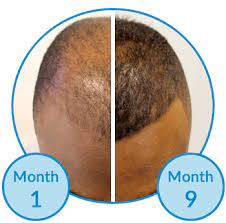Inflammatory Hair Loss

Inflammatory Hair loss is related to the presence of inflammation in the body and the scalp.
Stress, for example, not only impacts us on an emotional level but on a physical one too. By creating excessive inflammation in the body, hair loss can occur and as well as a general weakening of the immune system.
Male Pattern Baldness - What is Androgenetic Alopecia?

Hair loss is a common issue in both men and women, especially as they age. Many of us know men who started to lose their hair in their 20’s, culminating in the classic horseshoe shape associated with male pattern baldness, medically known as androgenetic alopecia (AA). Men are more commonly impacted than women, and caucasians are more commonly affected with AA than Asians and African Americans. Although the exact causes are not fully understood, AA appears to be a genetic condition where multiple genes are involved.
In men, hair loss tends to follow a pattern of recession at the hairline, temples, and ultimately at the crown of the head or vertex. This leads to sparing of hair along the temples and the back of the head, also known as the occiput. As hair loss proceeds, generalized thinning of the hair is noted as well. Several classifications exist to evaluate the pattern and extent of hair loss in AA, with the Norwood Classification being one of the most commonly utilized scales. This scale is rated from 1-7, with sub-categorization if there is additional loss at the hairline or the vertex. Higher scores are associated with greater degrees of hair loss.
Treating Hair Loss Starts At The Follicular Level
The underlying mechanism of hair loss in AA is thought to be mediated by hormonal changes that occur at the level of the hair follicle. In particular, the conversion of testosterone to the very potent androgen dihydrotestosterone (DHT), is a critical component of AA. An enzyme present in the skin called 5-alpha-reductase converts testosterone to DHT. The amount of DHT produced and thus the impact on hairs is determined by a variety of different factors. Some of the influences on the levels of DHT include the activity of the 5-alpha reductase enzyme, the amount of testosterone circulating in the blood stream (this is why men that abuse steroids often lose their hair, as the excess testosterone is converted to DHT), diet, lifestyle, stress and the function of your thyroid and other aspects of your endocrine system. Much of this is poorly understood, though thought to be heavily influenced by genetic factors.
Given the crucial role that DHT plays in AA, strategies to inhibit the production of DHT are logical treatments for male pattern baldness. One such approach has been with drugs that inhibit the conversion of testosterone to DHT, by blocking the action of 5-alpha-reductase.
